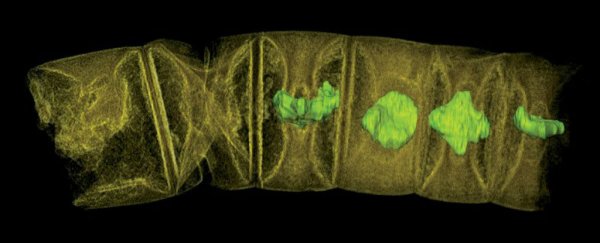Researchers have found what appears to be the oldest known evidence of plant life on Earth - two kinds of 1.6 billion-year-old fossils resembling red algae trapped in sedimentary rocks in central India.
If this really is algae as the team suspects, the discovery indicates that advanced multicellular life evolved much earlier on our planet than previously thought, and could bring into question important assumptions about the great 'Cambrian Explosion' that gave rise to most major animal groups in existence.
"You cannot be 100 percent sure about material this ancient, as there is no DNA remaining, but the characters agree quite well with the morphology and structure of red algae," says one of the team, Stefan Bengtson, from Swedish Museum of Natural History.
"The 'time of visible life' seems to have begun much earlier than we thought."
One of Bengtson's colleagues, Therese Sallstedt, was examining fossilised layers of primitive cyanobacteria called stromatolites, dug out of an ancient rocky outcrop in the Chitrakoot region of central India.
But then she noticed something strange: fossilised near the simple microbes was something that appeared far more advanced than it should have been - a fleshy, multicellular structure that looked distinctly like algae.
"I got so excited I had to walk three times around the building before I went to my supervisor to tell him what I had seen," says Sallstedt, who was a doctoral student at the time.
Not only were the unidentified organisms far larger than their cyanobacteria neighbours, but the way the cells in their tissues were arranged did not look like anything we've seen before the rise of eukaryotic - or complex - lifeforms.
"I had seen something similar a little bit before in other thin sections… but the 'eureka moment' was when I found this particular specimen [and] saw these colonies of algae," Sallstedt told Ian Sample at The Independent.
"That's when I realised, wow, this must be more advanced than microbes."
The team further investigated the fossils using an imaging technique called X-ray tomographic microscopy, which allowed them to identify regularly recurring platelets (tiny blood cells) in each cell, which they suspect are part of the organisms' chloroplasts - the place where photosynthesis occurs.
They also found certain structures at the centre of each cell wall that resemble known features in red algae, leading them to conclude that these creatures are likely to be the oldest samples of red algae ever found.
And that's important - radiometric dating has revealed these fossils to be roughly 1.6 billion years old, which is 400 million years more ancient that the previous oldest known sample of red algae, dated at 1.2 billion years.
The fact that red algae belongs on the eukaryotic family tree, which encompasses all complex organisms on the planet, including animals, plants, fungi, and protists, suggests that the beginnings of organisms that eventually led to us humans occurred even earlier in Earth's history than we thought.
"These fossils pre-date the previously earliest accepted red algae by about 400 million years, suggesting that eukaryotes may have a longer history than commonly assumed," says Sallstedt.
The find, if verified, also brings into question our assumptions about the Cambrian Explosion, which is thought to have started around 550 to 545 million years ago.
This unique moment in Earth's history gave rise to most major animal phyla (or groups) on the planet, but this discovery suggests that the event started much earlier than we thought, and happened more gradually.
"[I]f the authors are right, and they belong to crown group red algae (that is similar to the red algae that exist today), then their ancestors must be older, and perhaps as old as 2.3 billion years or more," Roger Summons, a geobiologist at MIT who was not involved in the study, told The Christian Science Monitor.
Of course, without any DNA evidence to back up the claims, we can never know for sure if what we're looking at in ancient, fossilised rock is what it appears to be.
Because of that uncertainty, claims of ancient life will always be controversial, so we're going to have to wait for more fossils to strengthen the case for this being some form of ancient algae.
But even if they're something other than red algae, their complexity is striking, and this could be the beginning of a rethink into how and when the earliest complex life on Earth came to be.
The research has been published in PLoS One.
